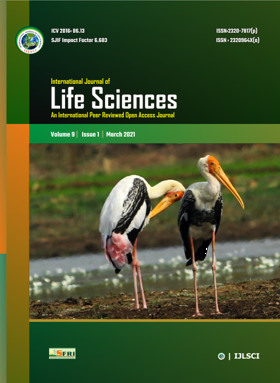Protozoans: Animals Or Protists?
Keywords:
Biological classification, Domains of life, Kingdom systems, Protozoa, WhittakerAbstract
Protozoans are single celled eukaryotes found worldwide with rich biodiversity. The protozoan species live in different habitats as free living or parasite having different shapes and adapted for various physiological activities. These are microscopic unicellular eukaryotes that have a relatively complex internal structure and carry out complex metabolic activities within a cell by highly specialized subcellular organelles like pseudopodia, flagella and cilia. Initially protozoans were kept in phylum Protozoa under kingdom Animalia as per classification of Linnaeus but later placed under kingdom Protista from three to six kingdom systems. In present article, author attempted to discuss the position of protozoa from two to six kingdom system of biological classification and finally concluded that protozoans are now protists, and not the animals.
Downloads
References
Aristotle (c. 350 BC). Historia Animalium. IX, 621b-622a.
Cavalier-Smith, T. (1993). Kingdom protozoa and its 18 phyla. Microbiol Rev. 57(4):953-994.
Cavalier-Smith, T. (1981). Eukaryote kingdoms: seven or nine? Bio Systems. 14 (3–4): 461-481. 10.1016/0303-2647(81)90050-2.
Copeland, H. F. (1956). The Classification of Lower Organisms. Palo Alto, Calif., Pacific Books. 10.5962/bhl.title.4474.
Goldfuss, GA (1818). Ueber die Classification der Zoophyten [On the classification of zoophytes]. Isis, Oder, Encyclopädische Zeitung von Oken (in German). 2 (6): 1008-1019
Goldfuss, Georg August (1820). Handbuch der Zoologie. Erste Abtheilung [Handbook of Zoology. First Part.] (in German). Nürnberg, (Germany): Johann Leonhard Schrag. pp. XI–XIV.
Haeckel, E (1866). Generelle Morphologie der Organismen. Berlin, G. Reimer. https://doi.org/10.5962/bhl.title.3953
Kudo, RR (1954). Protozoology. Springfield, Illinois: C.C. Thomas.
Levine, ND, Corliss, JO, Cox, FE, Deroux, G, Grain, J, Honigberg, BM, Leedale, GF, Loeblich, AR 3rd, Lom, J, Lynn, D, Merinfeld, EG, Page, FC, Poljansky, G, Sprague, V, Vavra, J, Wallace, FG. (1980). A newly revised classification of the protozoa. J Protozool. 27(1):37-58. 10.1111/j.1550-7408.1980.tb04228.x.
Linnaeus, C. (1758). Systema naturæ per regna tria naturæ, secundum classes, ordines, genera, species, cum characteribus, differentiis, synonymis, locis. 1 (10th ed.). Stockholm: Laurentius Salvius. [1-4p], 1-824.
Sapp, J (2005). The prokaryote-eukaryote dichotomy: meanings and mythology. Microbiology and molecular biology reviews. 69(2): 292–305. https://doi.org/10.1128/MMBR.69.2.292-305.2005
Siebold, von (1848). Lehrbuch der vergleichenden Anatomie [Textbook of Comparative Anatomy] (in German). vol. 1: Wirbellose Thiere (Invertebrate animals). Berlin, (Germany): Veit & Co.
Sina, MA et al. (2005). The New Higher Level Classification of Eukaryotes with Emphasis on the Taxonomy of Protists. The Journal of Eukaryotic Microbiology. 52 (5): 399-451. https://doi.org/10.1111/j.1550-7408.2005.00053.x
Soyer-Gobillard, MO (2006). Edouard Chatton (1883–1947) and the dinoflagellate protists: concepts and models. International Microbiology. 9 (3): 173–177.
Verma, AK (2016a). Evolution, Merits and Demerits of Five Kingdom System. Flora and Fauna. 22(1):76-78.
Verma, AK (2016b). Relevancy of Three Domain System of Biological Classification in Modern Context. International Journal on Biological Sciences. 7(1):35-39.
Verma, AK (2017a). A Handbook of Zoology. Shri Balaji Publications, Muzaffarnagar. 5th edn. 648p.
Verma, AK (2017b). Position of Protozoa in Five Kingdom System. International Journal on Biological Sciences. 8(1): 45-47.
Verma, AK and Prakash, S (2020). Status of Animal Phyla in different Kingdom Systems of Biological Classification. International Journal of Biological Innovations. 2 (2): 149-154. https://doi.org/10.46505/IJBI.2020.2211
Whittaker, RH (1969). New concepts of kingdoms of organisms. Science. 163 (3863):150-160. 10.1126/science.163. 3863. 150.
Woese, C., Kandler, O., Wheelis, M. (1990). Towards a natural system of organisms: proposal for the domains Archaea, Bacteria, and Eucarya. Proceedings of the National Academy of Sciences of the United States of America. 87 (12): 4576-4579. 10.1073/pnas.87.12.4576.
Downloads
Published
How to Cite
Issue
Section
License
Copyright (c) 2021 Ashok Kumar Verma

This work is licensed under a Creative Commons Attribution-NonCommercial-NoDerivatives 4.0 International License.
Open Access This article is licensed under a Creative Commons Attribution 4.0 International License, which permits use, sharing, adaptation, distribution and reproduction in any medium or format, as long as you give appropriate credit to the original author(s) and the source, provide a link to the Creative Commons license, and indicate if changes were made. The images or other third party material in this article are included in the article’s Creative Commons license unless indicated otherwise in a credit line to the material. If the material is not included in the article’s Creative Commons license and your intended use is not permitted by statutory regulation or exceeds the permitted use, you will need to obtain permission directly from the copyright holder. To view a copy of this license, visit http://creativecommons.org/ licenses/by/4.0/











